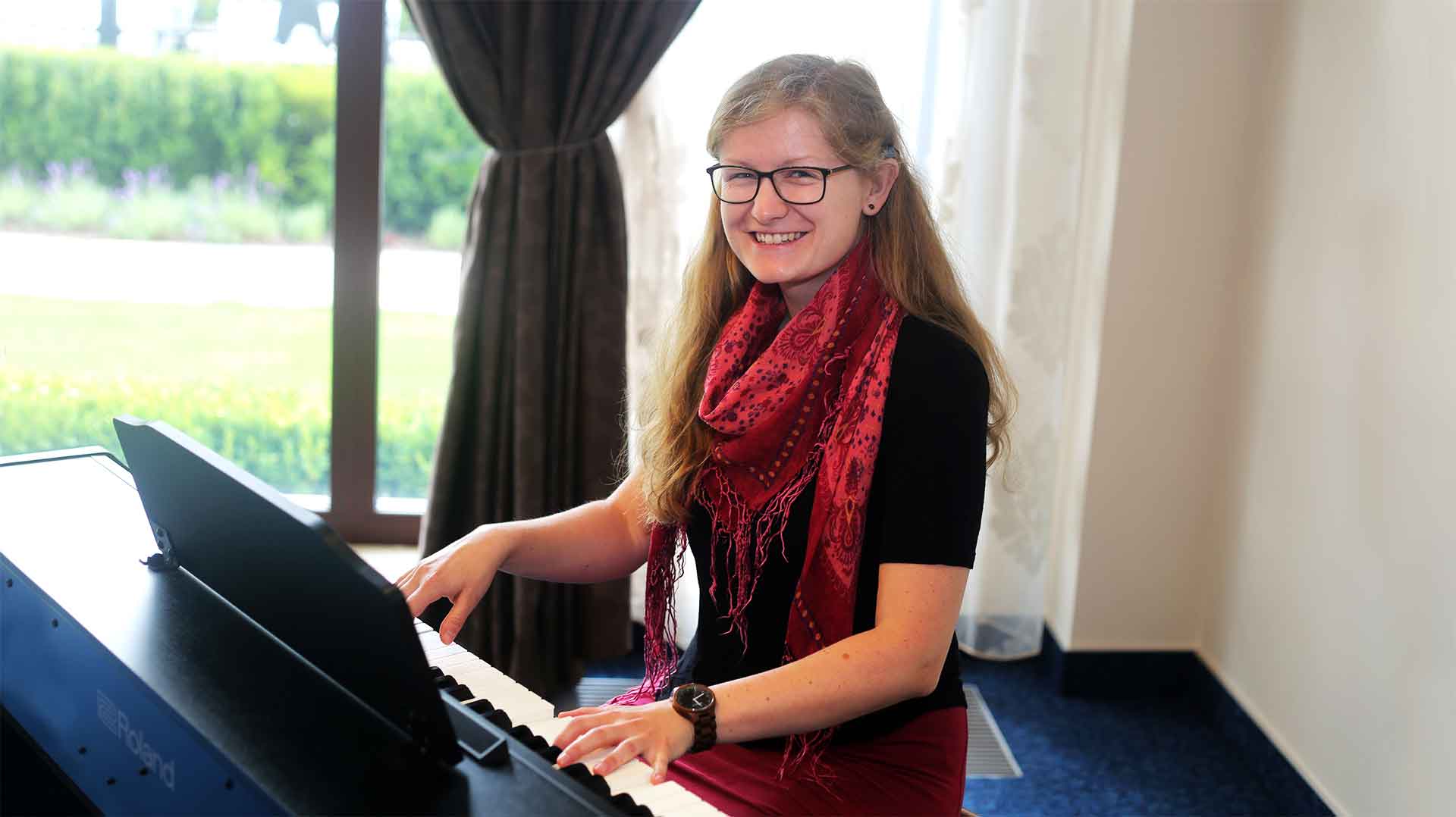MED-EL
Published Jul 19, 2017
10 Things That May Surprise You When You Get A Cochlear Implant

Veronika was born with regular hearing, and became deaf on her left ear aged 3 and a half years. For 18 years she lived with her single-sided deafness, thinking there was no solution for her type of hearing loss. After getting her MED-EL cochlear implant aged 21, Veronika now can’t imagine life without it. Six years on since getting her cochlear implant, improved hearing helps Veronika in all aspects of life, from her work as an occupational therapist and in her start-up “Holzspecht”, to playing piano, to catching up with friends and family. Here are Veronika’s top 10 things that surprised her when she got her CI.
1. There is just so much sound.
I will never forget when I went to a cafe right after activation. I took the water glass and placed it on a table—it was on a stone table. I could hear the glass hitting the table. I was almost in tears because I could now hear this with my left ear, which I hadn’t heard anything with for over 18 years. I remember being in the kitchen or my regular surroundings and I would hear something new and become so excited. For example, I would open and close the cupboard five times just because it was so amazing to hear it with my left ear.
2. I was tired quite a lot.
After I got my CI, I started rehabilitation, and had half hour sessions with a hearing professional to learn to hear with my CI. It was exhausting I have to say. After the half hour sessions I was very tired because I tried to concentrate really hard as I wanted to learn as quickly as possible.
3. I didn’t hear all sounds straight away.
I found the activation experience really good because they gradually activated more levels of hearing each visit, so not all frequencies were loud immediately. Because of this, I had time to adapt to each new frequency which was very helpful to me. However at the beginning using metallic cutlery was uncomfortable to me. I initially couldn’t stand it with the CI. So I got together with my MED-EL technician and we looked into how to make it better, which he was able to do for me! I think the fittings are so important and I think the audiologists and technicians do a brilliant job.
4. Electric stimulation and natural hearing go together just fine.
I know that previously there were concerns about whether natural hearing on one side and electric stimulation on the other side can work together. I can only speak for myself, but I found out that for me, they go together nicely. Some sounds, when listening to them only with the CI and without my right ear, do sound different than on my right natural hearing ear. However that does not bother me at all, as when hearing sounds together with both ears it works out nicely. Also I don’t mind the differences from my CI to my natural hearing ear as it even helps me in sound detection and localization, which was impossible before the CI.
5. The importance of fittings.
With using the CI every day and having rehabilitation sessions, my abilities to hear with the CI grew. But I noticed that, in my case, I was hearing metallic noises a lot louder than other sounds. That’s why I got together with MED-EL technicians and we worked on fine-tuning each frequency, especially focusing on high frequencies, so that I would be comfortable also with these sounds. We developed different programs for different hearing situations and I can switch between these programs with a remote and also do fine adjustments within the programs.
When I changed my job, there were swinging doors that were really making a metallic noise. I couldn’t stand that sound so I always had to switch my processor off which is not a good solution. So I got together with my MED-EL technician to adapt a program for the new hearing surroundings and he managed to fix my problem with the swinging doors, which is great! I think CI fittings, the fine-tuning of frequencies, is so very important because that’s what helps you in a lot of different hearing situations and makes them enjoyable.
6. Some things I didn’t realize I was missing out on before.
So many people think that “Oh you’ve got single-sided deafness, how can you do all that?” But I was doing ok with my hearing loss, having learnt how to lip read and how to read body language very well, amongst other things. However, now with the implant, I know I’m doing even better.
I’ll never forget the first time in the choir with my implant. I sing soprano and so in my choir I always stand more on the right-hand side. I could always hear parts of the other voices as well because the sound traveled to my good ear on the right, but the sound was not as full. It was only when I went to choir and could hear with my implant that I realized just how much sound there was, and how grand the choir really was! I had always been missing out on this before and being able to experience that now is truly amazing.
It also makes a difference when I’m playing piano because I can now hear better what I’m doing on the left-hand side. I can also hear others better when I play with them. It has changed the way I play music.
7. I had very minimal pain after the surgery.
Everything went really well during the surgery. I woke up and felt ready to go, kind of! Although when I went back home three days after the surgery, I kind of slept through the next two weeks. My body needed that to recover from the surgery, so I gave myself that time. Of course the area around my left ear was a little bit sore because I’d just had the surgery and the muscles in my neck were aching for some time, but it would be a wrong expectation to think anything else—of course there would be a little bit of pain when having had surgery. The scar healed beautifully, and the hair came back quickly and nicely too.
8. There can be improvements to all aspects of your life that you don’t expect.
Before the implant, when I would turn around to leave a queue, I would bump into the person behind me because I didn’t know there was anyone there. That’s doesn’t happen anymore, or very rarely. Also, at times, people were getting annoyed with me because it seemed like I was ignoring them, but actually I just couldn’t hear them. The cochlear implant has not only affected my social interactions with people, but also how my body functions because I can have an upright posture and don’t have to tilt all the time, which affects my body.
With my single-sided deafness, I remember that I was always very aware of where I was sitting. In school or university for example I always made sure that anything important being said was always on my right-hand side. I also developed some issues with my posture because of it—I would always turn my head to the left to get the input on my right ear which had good hearing. This affected my posture and my muscular-skeletal system. With the cochlear implant I don’t have to do this as much anymore.
9. There will always be ups and downs.
If you have a disability there will always be ups and downs. In fact, that’s just life, no matter whether you have a disability or not. So it’s ok to sometimes maybe feel frustrated with your disability but to know that “disability” still contains the word “ability” and that after “a down” there will be “an up” again—that’s just the way it is. Also I think it’s important to have an open mind when getting a CI—it was a process of learning. It’s important not to expect anything too soon and I think over time you’re able to adapt, to learn, and to be patient with yourself. I think of course it is always an individual decision whether to go for a CI or not. For me, the biggest deciding factor was that I saw a chance of improvement in quality of life for my whole future. I was only 21 when I got it and had my whole life ahead of me, so to me it was a huge improvement.
10. See it as a chance.
I feel that in my life there have been people who think, “Oh you have single-sided deafness, how can you do this” or, “How can you attend a regular school”, or, “How come your speech is good—you’re deaf in one ear?” To me it’s important to learn from being deaf. My boyfriend of three and a half years doesn’t treat me differently because of my deafness or cochlear implant. It’s not like he thinks, “Ok, she’s a good person although she is deaf in one ear”. I think in his eyes he sees me as an even better person because I have single-sided deafness and a CI, as both taught me so much. Without my single-sided deafness I would not have learnt to lip read and I wouldn’t be as good at reading body language. And being able to read body language so well is a big strength in my profession as an occupational therapist. Also without my CI I would not have participated in this year’s Beats of Cochlea festival, which I truly enjoyed. I feel that having single-sided deafness and a CI helped me grow as a person, so I wouldn’t change a thing.
I want to encourage people to do what they love, whether it is music or something else. Don’t let single-sided deafness, other people, or even you, limit yourself. See your hearing loss, and a cochlear implant, as a journey and a chance!
Thanks, Veronika!
Was there anything that surprised you about getting a cochlear implant? Let us know below!
MED-EL
Was this article helpful?
Thanks for your feedback.
Sign up for newsletter below for more.
Thanks for your feedback.
Please leave your message below.
Thanks for your message. We will reply as soon as possible.
Send us a message
Field is required
John Doe
Field is required
name@mail.com
Field is required
What do you think?
MED-EL


